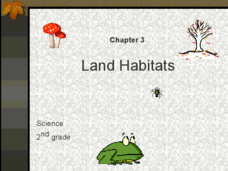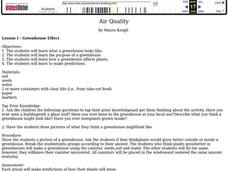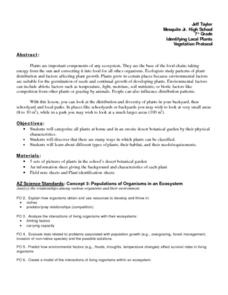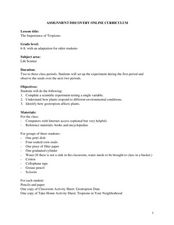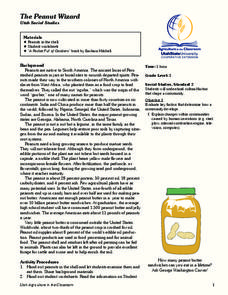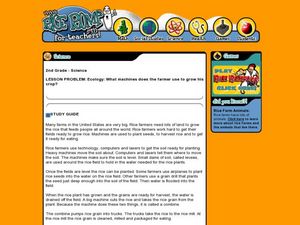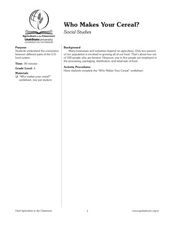Curated OER
Corn Harvest
Learners read Corn Belt Harvest and write sentences about corn's uses. They visit a cornfield and a grain elevator or have guest speakers come to class. They design posters about harvesting or processing corn into grain.
Curated OER
Red Leaf, Yellow Leaf
Students discuss the differences between a storybook and an information book. Students use various materials found in nature to make a nature collage. Students make a nature dictionary using pictures and their own definitions from the...
Curated OER
Land Habitats: Grade 3 Science
Build your students scientific vocabulary with this slide show on land habitats. Each slide provides a vocabulary word, image, and definition of a term common to habitats and the environment. Great for science class or as comprehensible...
Curated OER
Air Quality
Young scholars participate in many activities examining air quality. They examine the purpose of a greenhouse and make predictions. They also collect data and make graphs and charts.
Curated OER
U.S. History: Antebellum Heroes and Villains
Eighth graders research and write reports on key figures of the Antebellum Period. The projects also include pictures, bibliographies, and timelines about their assigned figure. In addition, 8th graders present oral reports to classmates.
Curated OER
Bud the Spud Moves West
As part of a unit on Canadian agriculture, this focuses on how potato farms have increased in the west. Pupils participate in a discussion about the impact of consumer demand on production, and then they read an article about potato...
Curated OER
Now You Have It, Now You Don't
Students compare shipping peanuts made from corn and made from Styrofoam. In this corn based peanuts lesson, students understand why to use eco-friendly materials for packing. Students participate in an experiment to compare the...
Curated OER
The Importance of Tropisms
Students investigate plant tropisms using the scientific method. In this life science lesson, students learn about tropisms and test the response of corn seedlings to gravity. Response questions, extensions, and an adaptation for older...
Curated OER
The Peanut Wizard
Students investigate the history of the peanut. In this social studies lesson, students read the book A Pocket Full of Goobers and examine the a peanut. Students discuss the peanut's characteristics and take notes on an article about...
Curated OER
Machines Rice Farmers Use
Second graders investigate rice farming. In this farming equipment lesson, 2nd graders discover what type of equipment is needed to get rice farms ready to plant. Students gain knowledge about what a combine does and how it is important...
Curated OER
In Strawberry Fields
Learners discuss the origin of strawberries and employees involved with picking strawberries. In this algebra instructional activity, students discuss how much a worker who picks strawberry makes based on their flats. They create a table...
Curated OER
Food's Altered Ego
Students write in their journals where they believe food comes from. After reading an article, they examine the proceses of cultivation and sale of genetically modified foods. Using the internet, they research specific countries and...
Curated OER
Buzzy, Buzzy Bee
Students simulate honeybees pollinating flowers. In this pollination lesson, students role-play the process of pollination over the course of several seasons. Students graph results and share their graphs with the class.
Curated OER
The Empty Pot: A Lesson About Integrity
Learners discuss whether honesty really is the best policy with a lesson on "The Empty Pot," a Chinese fable about integrity. After reading the story, class members answer several comprehension and reflection questions about what they...
Curated OER
Powerful Potato
Third graders make food. In this agriculture instructional activity, 3rd graders learn about the history of the potato. Students then plant potatoes, harvest them, and make french fries, potato salad or potato soup.
Curated OER
Bean Sprout
Student will track the growth of his/her bean sprout with sunlight and without sunlight over the course of 3 weeks. They will enter the results into an excel data base then graph the results of both variables to make the comparison.
Curated OER
Corn: An A-maizing Plant
Students explore the corn crop. In this farming instructional activity, students identify which states are in the corn belt and read about the history of corn, its uses and its development and growth. Students dissect a corn kernel....
Curated OER
How Groundhog's Garden Grew
Students answer questions based on Bloom's Taxonomy after reading the book, How Groundhog's Garden Grew, by Lynne Cherry. In this reading comprehension lesson, students respond to 6 questions, one per taxonomy level, to demonstrate...
Curated OER
Exploring Forest Objects
Students explore the forest. In this ecosystems instructional activity, students rotate through sensory activity centers, brainstorm, and read about temperate forests.
Curated OER
Flower Power
Students explore the parts of flowers and how they reproduce. They dissect flowers and observe the reproductive organs. Students observe anthers and ovaries of Tiger Lilies under a microscope. They investigate how insects and other...
Curated OER
Alphabet Letter a Or N Theme
Students draw a tree with acorns. They depict roots and an acorn in the soil to review plant growth and practice handwriting letter A or letter N in the writing lines. They cut an additional page for the mini-book to include the word...
Curated OER
6: Parts of a Flower
Students draw and label the parts of a flower using a coin from the Northern Mariana Islands. In this flower parts lesson, students look at a transparency of the reverse side of a quarter from the Mariana lslands. They discuss the...
Curated OER
Parts of the Flower and Pollination
Learners review the parts of the plant and recognize the parts that are important for pollination. In this pollination instructional activity, students illustrate and label the parts of a flower. Learners compare different types of...
Curated OER
Who Makes Your Cereal?
Fourth graders investigate how cereal is produced. In this agricultural lesson, 4th graders discuss where ingredients in cereal come from. Students use picture cards to identify the steps in producing cereal.




